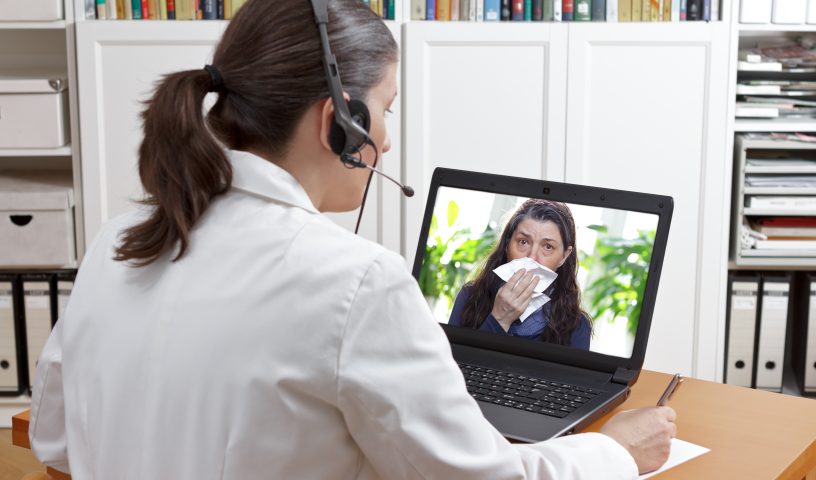
Jun 22, 2020
Spurred by crisis, telemedicine is revolutionizing health care as we know it
This is the first entry in a series detailing the UPMC Enterprises portfolio companies and technology solutions continuing to serve patients and providers during the COVID-19 pandemic. Follow our blog for upcoming entries.
Telemedicine, the remote delivery of health care using video and audio communication tools, is demonstrating itself as a necessary alternative to traditional in-person consultation. The COVID-19 pandemic has made this evident as both patients and providers are embracing telemedicine as a safer avenue of consultation that reduces the chances of exposure and spread of the virus. Its vital role during this time emphasizes how impactful remote care services can be in times of public health emergencies – and will likely have long-lasting effects on how health care is delivered even after the pandemic has passed.
COVID-19’s severe and contagious nature has led to an unprecedented increase in telemedicine usage. UPMC physicians have been conducting around 6,000 telemedicine visits each day – in fact, UPMC matched its total number of virtual visits in all of 2019 in just two days in March. The shift to virtual care consultations has reduced the possible spread of the COVID-19 virus and prevented bottlenecks at brick-and-mortar health care providers. UPMC AnywhereCare, for example, can see five times as many patients through the inherently more efficient telemedicine strategy than they could through traditional in-office visits.
UPMC portfolio companies specializing in telemedicine are also experiencing intensified demand for their services. Curavi Health implemented services into 28 new post-acute care facilities in need of safe, secure provider access in a 28-day span across March and April. Infectious Disease Connect, which provides smaller hospitals with access to infectious disease specialists via telemedicine, has increased its capacity to manage the surging demand for its services, including opening a call center to meet the volume of infectious disease consults needed within the UPMC system.
Outside of the COVID-19 pandemic, telemedicine’s benefits are already significant– immediate access to care, reduced cost, and simplified monitoring of one’s health. A key component of its appeal is convenience; patients, especially those in post-acute and long-term care facilities, can receive health care consultations without the burden of travel or unnecessary hospitalizations.
So, how commonplace is telemedicine becoming? Before the COVID-19 pandemic, telemedicine was already widely available. Over half of all U.S. hospitals were using some form of telemedicine. By the numbers, the global market is projected to grow from $38 billion in 2018 to over $130 billion by 2025.
Since the outbreak, analysts at Forrester Research revised their predictions for 2020 virtual care, suggesting virtual interactions are now on pace to top 1 billion by the end of the year. Another research group recently released data showing telehealth visits surged by 50% in March 2020.
The Benefits of Virtual Care
One recent survey demonstrated a public willingness to engage in telemedicine for routine health care consultations:
-
72% of parents with children under 18 said they’d be willing to see a doctor via video.
-
65% of respondents were interested in conducting video visits with their PCP.
-
20% of respondents said they would switch doctors to gain access to video visits.
This steep market development and patient interest can be summarized by telemedicine’s fundamental benefits: better access to health care, cost savings, improved quality, and easier patient engagement. And as more patients experience these benefits during the COVID-19 pandemic, experts believe the trend in utilization of telemedicine will continue.
Better Access
Previously, telemedicine addressed disparities in health care access by connecting rural and underserved populations to specialists. Now, providers and patients are seeing opportunities for telemedicine to allow for continued care in situations, like the COVID-19 pandemic, where in-person options have been compromised or otherwise unavailable.
Improved Quality
Telemedicine makes it easier for health care providers to follow up with patients, monitor symptoms remotely, and answer questions when needed.
Cost Savings
Reducing the cost of health care is one of the strongest motivating forces behind the drive to adopt telemedicine services. With patients more engaged in their care and the improved quality received, telemedicine can lead to better management of chronic diseases, more efficient doctor appointments, reduced travel costs, fewer unnecessary ER visits, and fewer and shorter hospital stays.
Patient Engagement and Demand
The ability to schedule remote appointments with direct access to health care professionals at one’s convenience and frequency invites patients to engage more avidly in their health. The ability to hold follow-up appointments also helps encourage long-term engagement.
As the health care industry adjusted to the government’s efforts to stopping the spread of COVID-19, telemedicine was relied on to provide remote care to a public adhering to shelter-in-place and social distancing measures. The technology continues to become more widely available through primary care physicians and health insurance providers. And as patients embrace a new wave of technology-enabled care, telemedicine and its capabilities can revolutionize the way we look at health care in the U.S. and throughout the world.


